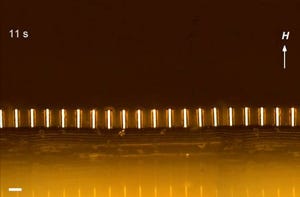This New Microhair Material Could Enable Lab-on-a-Chip Advances
August 12, 2014
Engineers at MIT have developed a new elastic material lined with microscopic, hairlike structures that can bend and tilt in response to a magnetic field. In experiments, the engineers were able to manipulate the microhairs to tilt in a certain direction based on the orientation of the magnetic field, in an effort to form a path through which fluid and light can flow.
|
The MIT-designed material is a flexible polymer "skin" coated with microhairs (white lines) that tilt in response to a magnetic field. (Photo courtesy of MIT) |
In the short term, researchers believe the material can be imbedded into lab-on-a-chip devices to magnetically direct the flow of cells and other biological material through a diagnostic chip's microchannels, according to a recent MIT news release.
Each microhair is about one-fourth the diameter of a human hair, and is made of nickel. Researchers designed an array of microhairs on an elastic, transparent layer of silicone that can be placed on a multitude of different surfaces and materials.
In recent experiments, the team piped a water solution through a syringe and onto a strip of silicone, filled with the microhairs. Once they placed the strip under a magnetic field, the liquid only flowed in the direction in which the microhairs tilted. Since the silicone layer is transparent, the group was also able to explore the effects on light.
The group began experimenting with shining a laser through the material while tilting the microhairs at various angles, and found that they could control how much light passed through, based on the angle of the tiny pillars. Much like window blinds can be tilted to redirect sunlight, these microhairs can bend under the influence of the magnetic fields to direct light in various directions.
Researchers believe this work could have waterproofing and anti-glare applications that could be put to use in office windows and cars. In principle, this microscopic material could be imbedded into office or home windows to help filter sunlight and repel raindrops more efficiently than ever before.
The study's findings were reported by Yangying Zhu, a graduate student in MIT's Department of Mechanical Engineering in this month's edition of Advanced Materials. The paper's co-authors, Evelyn Wang and Rong Xiao continue to research the potential applications of the design. Zhu noted that the silicone strips could also be strategically placed on a car windshield to manipulate rain drops and sunlight, allowing you to filter solar radiation while simultaneously shedding raindrops.
Since the material is extremely flexible, Wang notes that the silicone layer could potentially be woven into fabric to create rain-resistant clothing and other water resistant materials.
Refresh your medical device industry knowledge at MEDevice San Diego, September 10-11, 2014. |
Zhu remarked that the inspiration for the technology comes partly from nature. The human nasal passages are lined with cilia, tiny hairs that are designed to sway back and forth to remove dust and other foreign substances. The group sought to create a dynamic, responsive material that mimics the motion of cilia.
The application possibilities of this new technology are still vastly unexplored at this point, and Wang believes that the contours of the design make it an extremely applicable material. The group at MIT plan to continue to research the possibilities of this microscopic technology, and hope that it could soon expand the functionality of surfaces in a whole new way.
Kristopher Sturgis is a contributor to Qmed and MPMN.
Like what you're reading? Subscribe to our daily e-newsletter.
About the Author(s)
You May Also Like



